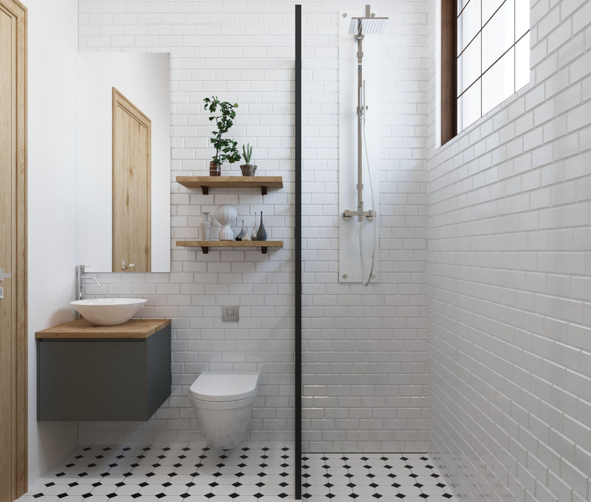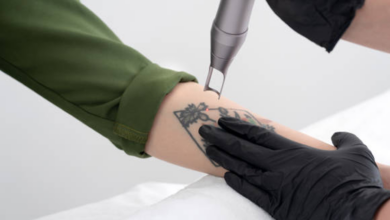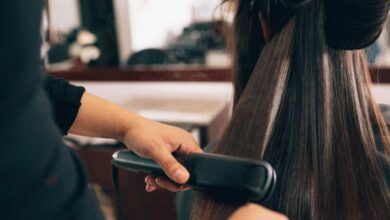The bathroom is arguably one of the most vital spaces in any home. It’s where we start and end our days, performing essential daily routines. For individuals with mobility difficulties, mobility bathrooms are paramount to maintaining independence and quality of life.
Two popular options for mobility bathrooms are wet rooms and accessible showers. In this in-depth exploration, we’ll dive into the pros and cons of each, helping you make an informed decision when transforming your bathroom.
Understanding Wet Rooms vs Accessible Showers
Before choosing if you should have a wet room or an accessible shower, it’s essential to grasp their fundamental differences.
Wet Room
A wet room is an entirely waterproof bathroom where the floor, walls, and ceilings are waterproofed to create an open, barrier-free space. A wet room is a bathroom space where the entire room serves as the shower enclosure, and there is no separate shower tray or bathtub. Instead, the entire floor of the wet room is gently sloped to ensure proper drainage.
Here’s a detailed explanation of what a wet room is and how it effectively drains water.
Key Components of a Wet room:
- Flooring: The flooring of a wet room is typically covered with waterproof materials such as tiles, natural stone, or specialized wetroom vinyl. The choice of flooring depends on aesthetic preferences and practical considerations.
- Waterproofing: Waterproofing is a critical aspect of wet room construction. Waterproof membranes or tanking systems are installed on the walls and floor to prevent water from seeping into the underlying structure and causing damage.
- Shower Area: The shower area in a wet room doesn’t have a traditional enclosure or tray. Instead, it usually features a wall-mounted or ceiling-mounted shower head and a glass partition or screen to contain splashes while allowing a sense of openness.
- Drainage System: The drainage system in a wet room is a key element that ensures efficient water removal. It consists of the following components:
- Drain: The drain is the central point where the water exits the wet room. It’s typically a floor drain that is strategically positioned to allow water to flow towards it. The drain can be a linear drain (a narrow, rectangular-shaped channel drain) or a point drain (a circular drain located in the center of the room).
- Trap: Beneath the floor, a trap is connected to the drain. The trap’s purpose is to prevent sewer gases from entering the room while allowing water to flow freely.
- Slope: The entire wetroom floor is gently sloped towards the drain. This slope ensures water naturally flows towards the drain, preventing puddles and stagnant water.
Benefits of Wet Rooms
Total Accessibility: Wet rooms are the epitome of accessible design. The absence of barriers or shower enclosures makes them perfect for wheelchair users or individuals with mobility aids.
Space Efficiency: Wet rooms can maximize space in a bathroom, making them a great choice for smaller bathrooms. The open design allows for layout flexibility and creates a sense of spaciousness.
Easy Maintenance: The waterproof nature of wet rooms simplifies cleaning and maintenance. There are fewer nooks and crannies for mold or mildew to develop.
Wetrooms offer several advantages, including easy accessibility for individuals with mobility challenges, low maintenance due to the absence of shower enclosures, and a contemporary, spacious feel. Proper drainage is at the heart of what makes a wetroom function effectively, ensuring that water is efficiently and safely removed from the space, preventing water damage, and maintaining a clean and dry bathroom environment.
Read Also: Unclog Your Drains: Effective Home Solutions
Accessible (Walk-In) Showers
An accessible shower refers to a shower area designed with specific accessibility features but is part of a more traditional bathroom layout. When choosing an accessible shower for wheelchair users, it’s crucial to consider various factors to ensure that it meets your specific needs and preferences.
Here are some different types of accessible showers and key considerations to keep in mind:
Types of Accessible Showers:
- Level access shower: This barrier-free shower allows a wheelchair user to roll directly into the shower area without encountering any thresholds or obstacles. They typically feature a wide entryway and a sloped floor that directs water toward a centrally located drain. Roll-in showers are the most wheelchair-friendly option.
- Curbless Showers: Curbless showers have a slightly raised threshold, but it is minimal and can be easily navigated by most wheelchairs. They provide a sleek, modern look while still offering accessibility. These showers often have a linear drain system that eliminates the need for a central drain.
- Transfer Showers: Transfer showers are designed for individuals who can transfer from wheelchairs to shower seats. These showers have a built-in bench or fold-down seat, grab bars, and a handheld showerhead for convenience. Ensure that the shower seat is at an appropriate height for easy transfer.
Key Considerations When Choosing an Accessible Shower for Wheelchair Users:
Size and Layout: Consider the size of the shower and whether it provides ample space for a wheelchair to maneuver comfortably. Ensure that the layout allows for easy entry and exit.
Threshold: If you opt for a curbless or roll-in shower, check the height of the threshold. It should be as low as possible to minimize any barriers for wheelchair users.
Grab Bars: Install grab bars in strategic locations within the shower to provide stability and support for transferring or maintaining balance. Grab bars should be securely mounted to the wall.
Shower Controls: Ensure that the shower controls are within reach of a seated position in a wheelchair. Lever-style controls are often easier to operate than traditional knobs.
Non-Slip Flooring: Select a slip-resistant flooring material to enhance safety within the shower. Textured tiles or non-slip mats can provide additional traction.
Shower Seat: If you choose a transfer shower, make sure the built-in or fold-down seat is sturdy, at an appropriate height, and securely attached to the wall.
Handheld Showerhead: A handheld showerhead on a flexible hose allows greater flexibility in directing water flow and is especially useful for individuals with limited mobility.
Shower Doors: Consider the type of enclosure you prefer. Ensure that the access method is easy for you to use.
Benefits of Accessible Showers
Cost-Effective: Accessible showers are more cost-effective than wet rooms, making them a budget-friendly choice for bathroom accessibility modifications.
Versatility: You can adapt an existing bathroom by incorporating an accessible shower without a complete overhaul. This can be especially advantageous if you’re on a tight budget or have limited space.
Privacy and Temperature Control: Accessible showers typically have a designated shower area with enclosures or curtains, providing more privacy and better temperature control.
Choosing an accessible shower for wheelchair users involves thoughtful planning and consideration of individual needs. By selecting the right type of shower and paying attention to key design elements, you can create a safe and comfortable bathing space that enhances your daily routine and promotes independence.
Take Away
The choice between a wet room and an accessible shower depends on various factors, including your budget, space, and personal preferences. Both options can create an accessible and comfortable bathroom for individuals with mobility challenges.
To make the right decision, consult an occupational therapist or specialist mobility bathroom contractor who can assess your needs and help you create a bathroom that suits your unique circumstances. Ultimately, whether you opt for the open, more accessible design of a wet room or prefer to modify your bathroom with an accessible shower, both options can enhance your quality of life and promote independence.
Disabled Facilities Grants (DFGs) for Mobility Bathrooms
The UK government aims to help individuals with disabilities continue living independently and safely in their own homes. To achieve this goal, the government provides Disabled Facilities Grants (DFGs) to fund essential home modifications.
These grants, administered by local authorities, play a vital role in eliminating barriers and improving accessibility within the home. They allow people with disabilities to make necessary changes to their properties, such as installing mobility bathrooms.
Apply for a Disabled Facilities Grant.









